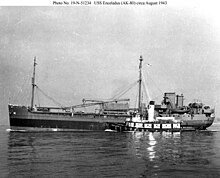
Coastal trading vessels, also known as coasters or skoots, are shallow-hulled merchant ships used for transporting cargo along a coastline. Their shallow hulls mean that they can get through reefs where deeper-hulled seagoing ships usually cannot (26-28 feet), but as a result they are not optimized for the large waves found on the open ocean. Coasters can load and unload cargo in shallow ports. For European inland waterways, they are limited to a 33,49 m beam.

World War II


During World War II there was a demand for coasters to support troops around the world.
Type N3 ship and Type C1 ship were the designations for small cargo ships built for the United States Maritime Commission before and during World War II. Both were use for close to shore and short cargo runs. The Government of the United Kingdom used Empire ships type Empire F as merchant ships for coastal shipping. British seamen called these "CHANTs", possibly because they had the same hull form as Channel Tankers (CHANT); initially all the tankers were sold to foreign owners and therefore there was no conflict in nomenclature. The USA and UK both used coastal tankers also. UK used Empire coaster tankers and T1 tankers. Many coasters had some armament, such as a 5-inch (127 mm) stern gun, 3-inch (76.2 mm) bow anti-aircraft gun and Oerlikon 20 mm anti-aircraft gun. These were removed after the war.
After the war many of the ships were sold to private companies all around the world.
Shipyards
Major coastal trading vessel shipyards include:
- Avondale Shipyard and Marine Ways
- Consolidated Steel Corporation (Long Beach & Wilmington)
- Froemming Brothers
- Globe Shipbuilding Company
- Ingalls Shipbuilding Corporation (Decatur, AL)
- J. A. Jones Construction Company (Brunswick)
- Kaiser Richmond No. 4
- Leathem D. Smith Shipbuilding Company
- Pennsylvania Shipyards Inc.
- Southeastern Shipbuilding Corporation
- Walter Butler Shipbuilders Inc. (Superior and Duluth)
See also
- Short sea shipping
- Bangkokmax ships (172x28.4x8,08m)
- Bangkok Port (172m length, 25m beam -with special permit 30m-, 8,2m draft), Bangkokmax of 1944 TEU
- Seawaymax (USA Great Lakes docks, 8,08m draft), Chesapeake & Delaware Canal (draft 10,7m)
- Type C1 ship standard allies coastal transport ships in World War II
References
- Louis, Murray A. "Skoots to the Rescue: A Microcosm of the Dunkirk Evacuation, Operation "Dynamo"" (PDF). The Journal of the Orders and Medals Society of America. 51 (1). Retrieved 1 February 2021.
- National Park Service, Scotts Bluff
- T. Colton. "N-Type Coastal Cargo Ships". Merchant Ship Construction in U.S. Shipyards. Archived from the original on 3 November 2011. Retrieved 12 January 2012.
- Auke Visser's, T1 Tanker types
- navsource.org USS Klickitat (AOG-64)
- shipbuildinghistory.com, T-1 Tankers
- marad.dot.gov, Coastal Tankers
- marad.dot.gov, Coastal Tanker
- "marad.dot.gov, Activation specifications for t1 -m-bt2 tanker" (PDF). Archived from the original (PDF) on 2019-08-06. Retrieved 2019-08-06.
- Mitchell, William Harry & Sawyer, Leonard Arthur (1990). The Empire Ships (2nd ed.). London, New York, Hamburg, Hong Kong: Lloyd's of London Press Ltd. ISBN 1-85044-275-4.
- "NJ Scuba, Tanker". Archived from the original on 2016-10-07. Retrieved 2019-08-06.
- USM shipyards, usmm.org
External links
- Historia y Arqueología Marítima - Los buques cargueros tipo N3 (Spanish, with diagram & photos
- The Bay of Pigs Invasion-The sinking of the Houston (photos)
- (N3-M-A1 variant) Shipscribe: ENCELADUS (AK-80)
- (N3-M-A1 variant) Shipscribe: BAK-1 (S.S. Asa Lothrop)
- Ships of the U.S. Navy, 1940-1945
| Modern merchant ships | ||
|---|---|---|
| Overviews | ||
| Dry cargo | ||
| Tankers | ||
| Passenger | ||
| Support | ||
| Other types | ||
| Related | ||